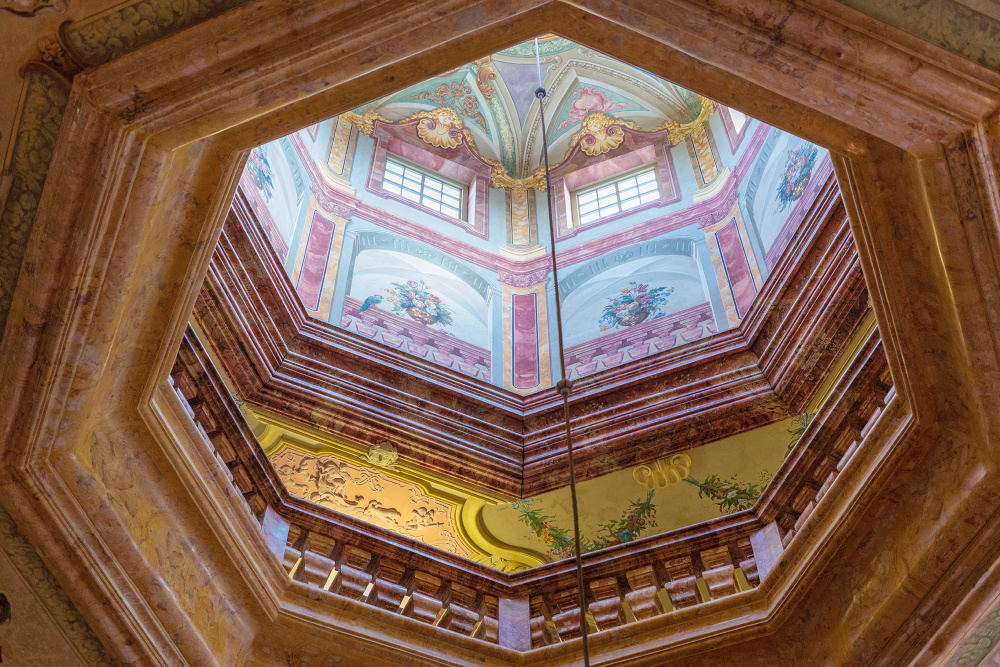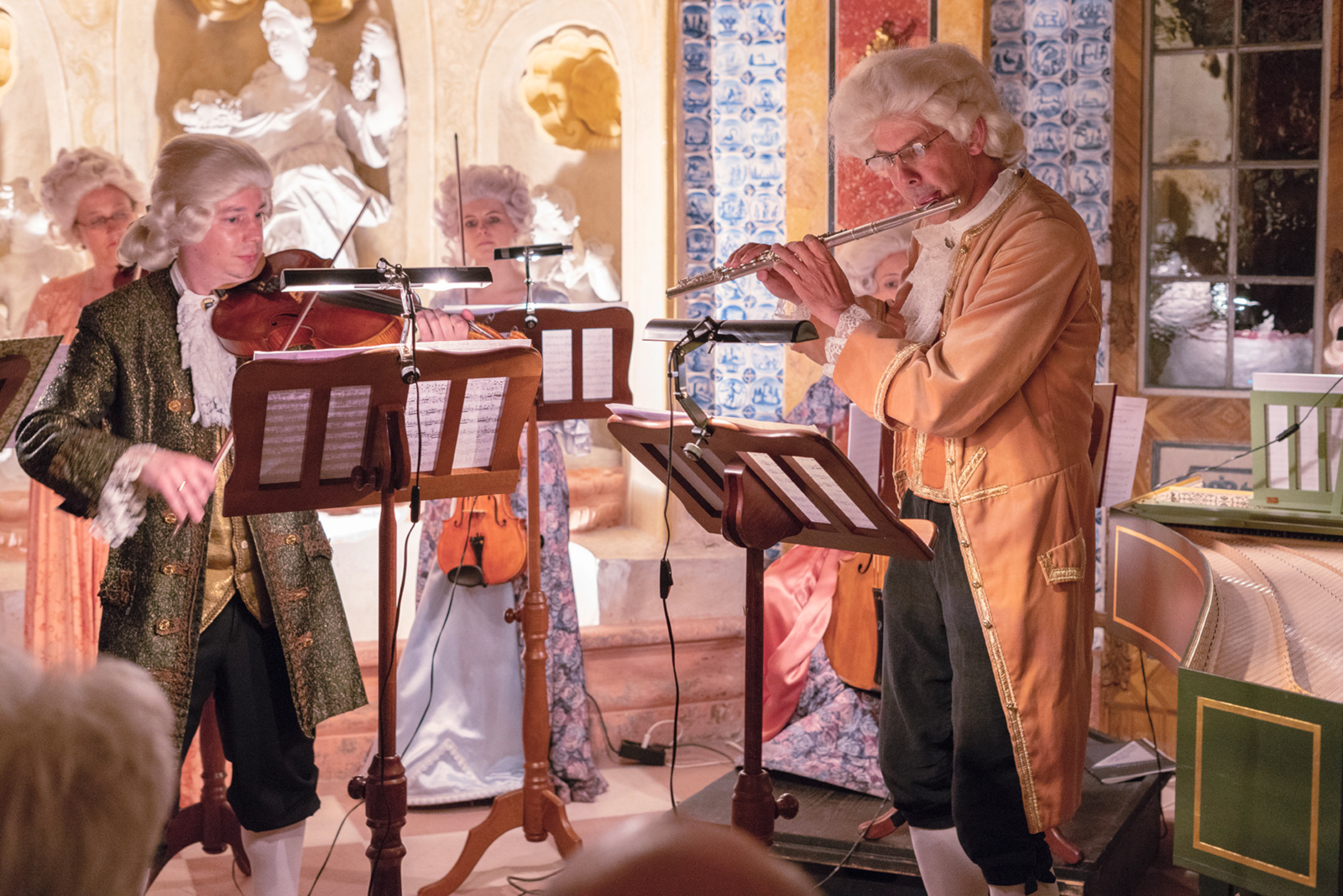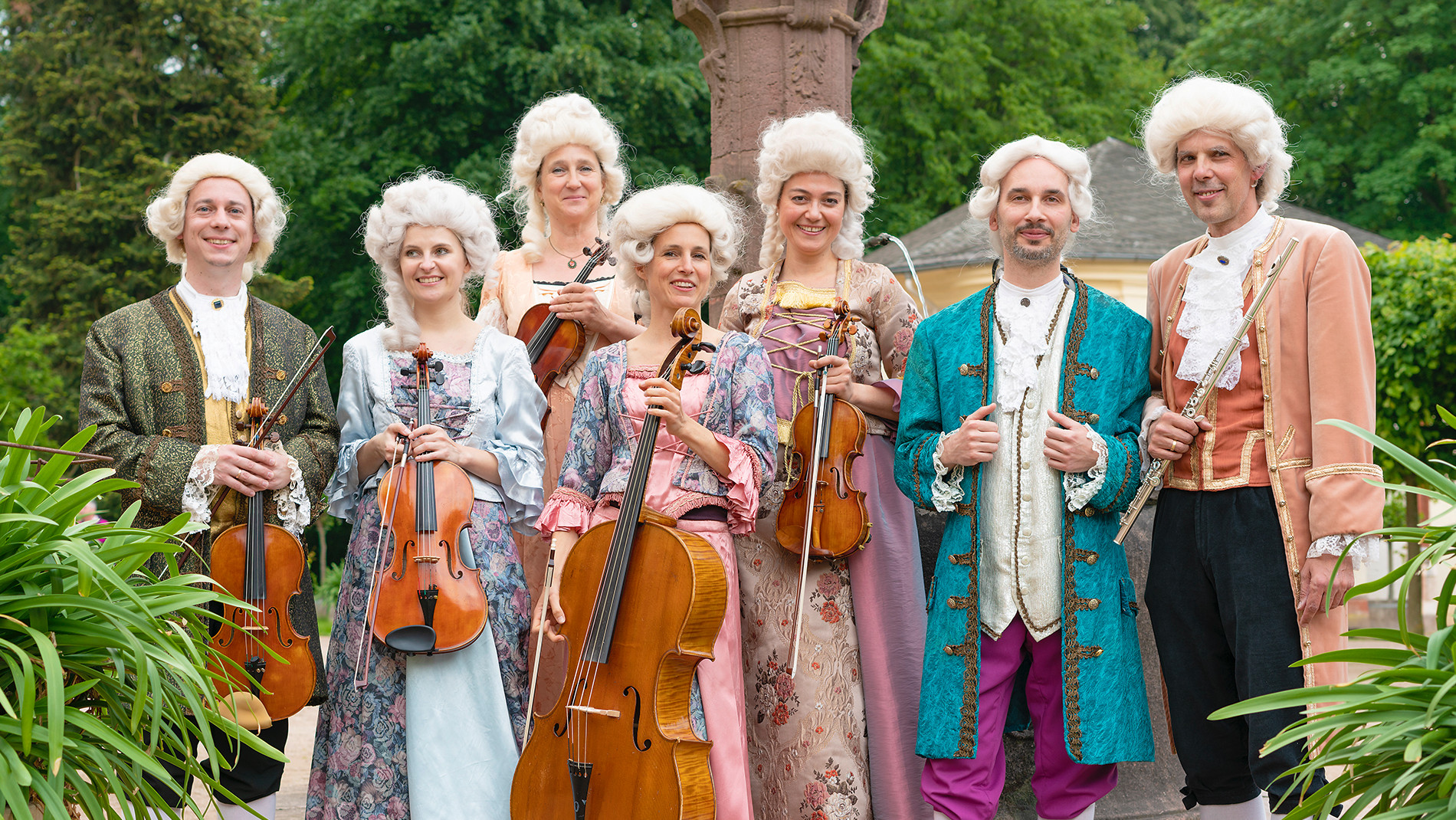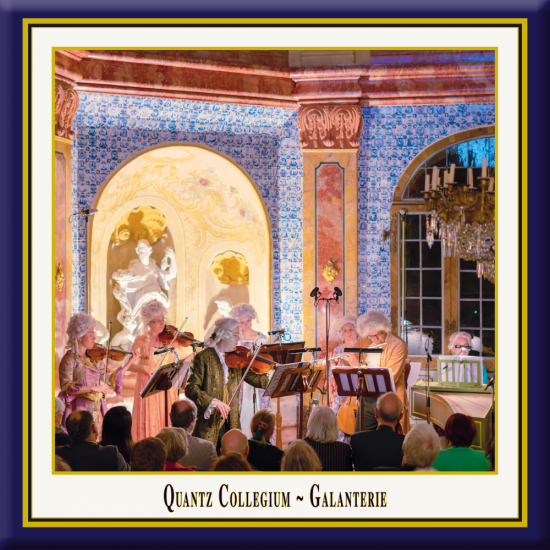Soundscape Rastatt Favorite Palace: Gallantry
Galanterie · Gallantry
The Quantz Collegium plays
Concertos for Flute, Viola, Strings & Basso continuo:
Christoph Graupner (1683-1760):
Concerto for Viola in D Major, GWV 314
Friedrich Wilhelm Heinrich Benda (1745-1814):
Concerto for Flute in G Major, Op. 4.1
Georg Philipp Telemann (1681-1767):
Concerto for Viola in G Major, TWV 51:G9
Christoph Graupner (1683-1760):
Concerto for Flute & Viola in D Minor, GWV 725
Artistic Director: Jochen Baier
A live recording from Rastatt Favorite Palace in Germany
HD Recording · DDD · Duration: c. 59 Minutes



R
astatt Favorite Palace (Schloss Favorite Rastatt) is the oldest German "porcelain palace" and the only one to survive almost unchanged to this day. Its opulent interiors, extensive collections and idyllic setting lend it Europewide significance. This enchanting Baroque summer residence and hunting palace was built from 1710 to 1727 for the young Margravine Sibylla Augusta of Baden-Baden (1675-1733). At Favorite Palace, which is just a short carriage ride from Rastatt Residential Palace, the court met for festivities involving hunting, concerts and banquets.
No expense was spared on the palace interiors, which are replete with all forms of 18th century craftsmanship: colourful scagliola floors made from imitation marble, walls with faience tiles, ceilings adorned with plasterwork and frescoes, sumptuous embroidered tapestries and priceless furniture. As well as demonstrating Sibylla Augusta's exquisite taste, this opulence served to portray her as a refined and cultured ruler. The jewel in the crown is the Florentiner Kabinett (Florentine room), which is still in its original condition and the only one of its kind in Europe. 758 panels cover the walls in a kaleidoscope of colour. Crafted from marble, granite and semiprecious stones, with breathtaking perfection, each panel is a work of art in its own right.
To accompany the magnificent décor, Sibylla Augusta amassed an unparalleled collection of Asian and European porcelain, glass and faience - earning the title "porcelain palace". Much admired by her contemporaries, the Margravine's astonishing hoard survives to this day. It is now the world's largest collection of early Meissen porcelain. Favorite Palace also offers a dazzling display of Chinoiserie in all its forms. Textiles, lacquer and ceramics bear witness to early 18th century Europe's penchant for all things Asian.
With its perfectly preserved 18th century interiors, Favorite Palace is a cultural heritage site of extraordinary significance. The building is surrounded by a charming English-style landscape park. In the Margravine's day, the gardens featured tree-lined avenues, symmetrical parterres with fountains and orangeries. Some of these Baroque garden features have survived, making a stroll through the park a delightful exercise.
Copyright of this text by www.schloss-favorite-rastatt.de. All rights reserved.
This concert took place in the "Sala Terrena" (Garden Hall) of the Rastatt Favorite Palace in Germany - an highly unusual ballroom, which extends through all floors of the building. The palace and the garden are one of 60 historic monuments in the Germany's Southwest. The "State Organisation for Palaces and Gardens of Baden-Württemberg" (in German: "Staatliche Schlösser und Gärten Baden-Württemberg") makes accessible, communicate, develops and preserves these state-owned historic monuments with the aim of preserving the authenticity of the cultural heritage, filling them with life and preserving them for future generations. Detailed information about these unique "Soundscapes" can be found at: www.schloesser-und-gaerten.de
I
n music, "galant" refers to the style which was fashionable from the 1720s to the 1770s. This movement featured a return to simplicity and immediacy of appeal after the complexity of the late Baroque era. This meant simpler, more song-like melodies, decreased use of polyphony, short, periodic phrases, a reduced harmonic vocabulary emphasizing tonic and dominant, and a clear distinction between soloist and accompaniment. C. P. E. Bach and Daniel Gottlob Türk, who were among the most significant theorists of the late 18th century, contrasted the galant with the "learned" or "strict" styles (Bach 1753, passim; Türk 1789, p. 405). The German "empfindsamer Stil", which seeks to express personal emotions and sensitivity, can be seen either as a closely related North-German dialect of the international "galant style" (Heartz and Brown 2001a; Heartz and Brown 2001b; Palmer 2001, xvii; Wolf 2003), or as contrasted with it, as between the music of Carl Philipp Emmanuel Bach, a founder of both styles, and that of Johann Christian Bach, who carried the galant style further and was closer to classical.
The word "galant" derives from French, where it was in use from at least the 16th century. In the early 18th century, a "Galant Homme" described a person of fashion; elegant, cultured and virtuous. The German theorist Johann Mattheson appears to have been fond of the term. It features in the title of his first publication of 1713, "Das neu-eröffnete Orchestre", oder "Universelle und gründliche Anleitung wie ein Galant Homme einen vollkommenen Begriff von der Hoheit und Würde der edlen Music erlangen". (Instead of the Gothic type rendered here in italics, Mattheson used Roman to emphasize the many non-German expressions (Mattheson 1713, title page; Heartz and Brown 2001)). Mattheson was apparently the first to refer to a "galant style" in music, in his "Das forschende Orchestre" of 1721. He recognized a lighter, modern style, einem galanten Stylo and named among its leading practitioners Giovanni Bononcini, Antonio Caldara, Georg Philipp Telemann, Alessandro Scarlatti, Antonio Vivaldi and George Frideric Handel (Heartz 2003, p. 18). All were composing Italian opera seria, a voice-driven musical style, and opera remained the central form of galant music. The new music was not as essentially a court music as it was a city music: the cities emphasized by Daniel Heartz, a recent historian of the style, were first of all Naples, then Venice, Dresden, Berlin, Stuttgart and Mannheim, and Paris. Many galant composers spent their careers in less central cities, ones that may be considered consumers rather than producers of the style galant: Johann Christian Bach and Carl Friedrich Abel in London, Giovanni Paisiello in St Petersburg, Georg Philipp Telemann in Hamburg, and Luigi Boccherini in Madrid.
The rejection of so much accumulated learning and formula in music is paralleled only by the rejection in the early 20th century of the entire structure of key relationships. Not every contemporary was delighted with this revolutionary simplification: Johann Samuel Petri, in his "Anleitung zur praktischen Musik" (1782) spoke of the "great catastrophe in music" (Blume 1970, p. 20).
The change was as much at the birth of Romanticism as it was of Classicism. The folk-song element in poetry, like the singable cantabile melody in galant music, was brought to public notice in Thomas Percy's Reliques of Ancient Poetry (1765) and James Macpherson's "Ossian" inventions during the 1760s.
Some of Telemann's later music and of Bach's sons, Johann Quantz, Hasse, Giovanni Battista Sammartini, Giuseppe Tartini, Baldassare Galuppi, Johann Stamitz, Domenico Alberti, and early Mozart are exemplars of galant style. Some of the works of the Portuguese composer Carlos Seixas are firmly in the galant style.
This simplified style was melody-driven, not constructed, as so much classical music was to be, on rhythmic or melodic motifs: "It is indicative that Haydn, even in his old age, is reported to have said, 'If you want to know whether a melody is really beautiful, sing it without accompaniment'" (Blume 1970, p. 19). This simplification also extended to harmonic rhythm, which is generally slower in galant music than is the case in the earlier baroque style, thus making lavish melodic ornamentation and nuances of secondary harmonic colorings more important (Palmer 2001, xvii).
The affinities of galant style with Rococo in the visual arts are easily overplayed, but characteristics that were valued in both genres were freshness, accessibility and charm. Watteau's fêtes galantes were rococo not merely in subject matter, but also in the lighter, cleaner tonality of his palette, and the glazes that supplied a galant translucency to his finished pictures often compared to the orchestrations of galant music (Heartz 2003).
From Wikipedia, the free encyclopedia

C
hristoph Graupner (13 January 1683 in Kirchberg - 10 May 1760 in Darmstadt) was a German harpsichordist and composer of high Baroque music who was a contemporary of Johann Sebastian Bach, Georg Philipp Telemann and George Frideric Handel. Born in Hartmannsdorf near Kirchberg in Saxony, Graupner received his first musical instruction from his uncle, an organist named Nicolaus Kuester. Graupner went to the University of Leipzig where he studied law (as did many composers of the time) and then completed his musical studies with Johann Kuhnau, the cantor of the Thomasschule (St. Thomas School). In 1705 Graupner left Leipzig to play the harpsichord in the orchestra of the Hamburg Opera under the direction of Reinhard Keiser, alongside George Frideric Handel, then a young violinist. In addition to playing the harpsichord, Graupner composed six operas in Hamburg, some of them in collaboration with Keiser, a popular composer of operas in Germany. In 1709 Graupner accepted a post at the court of Hesse-Darmstadt and in 1711 became the court orchestra's Hofkapellmeister (court chapel master). Graupner spent the rest of his career at the court in Hesse-Darmstadt, where his primary responsibilities were to provide music for the court chapel. He wrote music for nearly half a century, from 1709 to 1754, when he became blind. He died six years later... [From Wikipedia, the free encyclopedia]
F
riedrich Wilhelm Heinrich Benda (15 July 1745 in Potsdam - 19 June 1814 in Potsdam) was a German violinist, pianist and composer. Benda was the son of violin virtuoso and composer Franz Benda, from whom he received his first musical lessons. Later he studied music theory and composition with Johann Kirnberger in Berlin. In addition to his compositional achievements, he was an accomplished pianist and violinist. In the years 1765–1810, Benda was a chamber musician at the Prussian Court in Potsdam where his compositions found much acceptance. Benda composed concertos, operas, and chamber Music... [From Wikipedia, the free encyclopedia]
T
he first founding of the Quantz Collegium dates back to 1936, when the then 22-year-old flutist Ernst Friedrich Wilhelm Bodensohn (1914-2003) founded a chamber music ensemble and gave him the name of the "father" of the German flute history, Johann Joachim Quantz. The 2nd World War destroyed all further plans. After the war, Bodensohn became the first solo flutist of the newly founded SWR-Symphony-Orchestra in Baden-Baden and lived there with his family. In addition to his orchestral work under the conductors Hans Rosbaud (1895-1962) and Ernest Bour (1913-2001), he founded in the 1950s with colleagues once again the Quantz Collegium. After discovering the wonderful "Favorite Palace" near Rastatt in Germany, he succeeded with great commitment in 1957 for the first time to perform the "Festive Serenades at Rastatt Favorite Palace". The today since more than 60 years existing concert series is charcterized by one particular aspect: The less known composers of the Baroque and Classical periods should be made accessible to the public by confrontating them with the great, unforgettable masters of music history.

Jochen Baier ~ Flute & Artistic Leading
Boriana Baleff & Gundula Jaene ~ Violin · Agata Zieba & Kilian Ziegler ~ Viola
Regina Wilke ~ Cello · Slobodan Jovanovic ~ Harpsichord
Furthermore, the historical ensemble of the namesake Johann Joachim Quantz at the court of Frederick II. is role model and obligation for a further focus on musical content: The performance of flute music from the Baroque and the Classical era. With these two programmatic weightings, it has now been possible to achieve an extraordinary variety and longevity with this concert series. An inner desire of the ensemble is the helping to preserve the music of the past in its great diversity and to offer it to the public with living performances. The concerts in the splendid "Sala Terrena" (Garden Hall) of the "Rastatt Favorite Palace" (Schloss Favorite Rastatt), combined with the "historical" costumes of the musicians, resulted in the today's special reputation of the concert series and its almost historical dimension.
Since 1982 Jochen Baier has been flutist and since 1991 flutist and leader of the ensemble. Under his direction, the ensemble has developed a wealth of programs through the variety of participating musicians and through intensive researches in libraries and archives. More than 2000 different compositions were performed during this time. During 540 concerts so far (until 2017), about 300 different composers were musically introduced and their curriculum vitae were presented in the historical context with text explanations. So far the concerts have been performed by more than 150 different musicians. Some of whom participated in one concert only. Others, as member of the ensemble, influenced the concert series with their activity through years or decades. View more information (in German) under: www.festliche-serenaden.de.
P
ublishing Authentic Classical Concerts entails for us capturing and recording outstanding performances and concerts for posterity. The performers, audience, opus and room enter into an intimate dialogue that in its form and expression, its atmosphere, is unique and unrepeatable. It is our aim, the philosophy of our house, to enable the listener to acutely experience every facet of this symbiosis, the intensity of the performance, so we record the concerts in direct 2-Track Stereo digital HD. The results are unparalleled interpretations of musical and literary works, simply - audiophile snapshots of permanent value. Flourishing culture, enthralling the audience and last but not least also you the listener, are the values we endeavor to document in our editions and series.
Andreas Otto Grimminger & Josef-Stefan Kindler, K&K Verlagsanstalt
Christoph Graupner (1683-1760):
Concerto in D Major, GWV 314
for Viola, 2 Violins, Viola and Basso continuo
Soloist: Agata Zieba (Viola)
1. I. Vivace [3:24] ~ 2. II. Adagio [3:04] ~ 3. III. Vivace [4:34]
Friedrich Wilhelm Heinrich Benda (1745-1814):
Concerto in G Major, Op. 4.1
for Flute, 2 Violins, Viola and Basso continuo
Soloist: Jochen Baier (Flute)
4. I. Allegretto [7:49] ~ 5. II. Cantabile [5:04] ~ 6. III. Rondo [4:38]
Georg Philipp Telemann (1681-1767):
Concerto in G Major, TWV 51:G9
for Viola, 2 Violins, Viola and Basso continuo
Soloist: Kilian Ziegler (Viola)
7. I. Largo [3:27] ~ 8. II. Allegro [3:03]
9. III. Andante [3:50] ~ 10. IV. Presto [3:01]
Christoph Graupner (1683-1760):
Concerto in D Minor, GWV 725
for Flute, Viola, 2 Violins, Viola and Basso continuo
Soloists: Jochen Baier (Flute) & Kilian Ziegler (Viola)
11. I. Largo [2:30] ~ 12. II. Vivace [5:33]
13. III. Andante [3:43] ~ 14. IV. Vivace [4:22]
15. Applaus [0:38]
A Live Recording to 'Direct-Stereo-Digital-HD'
from Rastatt Favorite Palace in Germany, documented, produced & released
by Andreas Otto Grimminger & Josef-Stefan Kindler
Concert Date: May 19 & 20, 2018
Sound Engineer: Andreas Otto Grimminger
Production & Mastering: Andreas Otto Grimminger & Josef-Stefan Kindler
Photography, Artwork & Coverdesign: Josef-Stefan Kindler

The Rastatt Favorite Palace in Germany
This concert took place in the "Sala Terrena" (Garden Hall) of Rastatt Favorite Palace (Schloss Favorite Rastatt) in Germany. The Palace is the oldest German "porcelain palace" and the only one to survive almost unchanged to this day. The palace and the garden are one of 60 historic monuments in the Germany's Southwest. The "State Organisation for Palaces and Gardens of Baden-Württemberg" (in German: "Staatliche Schlösser und Gärten Baden-Württemberg") makes accessible, communicate, develops and preserves these state-owned historic monuments with the aim of preserving the authenticity of the cultural heritage, filling them with life and preserving them for future generations. Detailed information about these unique "Soundscapes" can be found at: www.schloesser-und-gaerten.de

***** A memorable mash-up
A musical revolution occurred in about 1720, with the "style galant" replacing the more learned and complicated music in vogue before then. K&K Verlagsanstalt, which specializes in audiophile recordings made in historic churches and palaces, has put together a winning project here, with the venerable Quantz Collegium (established in 1936) performing highly appealing music from the Garden Hall of the Rastatt Favorite Palace in Baden-Württemberg. Recorded at two live concerts, we have here four concertos for viola or flute, or both, by Graupner, Telemann and FWH Benda, all written in the accessible, tuneful new style. Mention should be made of Josef-Stefan Kindler's superb photos in the CD notes, which I at first took for paintings in the Rococo style of Tiepolo. They capture both the spirit of the original music and venue and that of the Quantz Collegium and K&K's Historically Informed reconstructions.
"Every current of fashion or of worldview", says Walter Benjamin in The Arcades Project, "derives its force from what is forgotten." Three centuries on, the stripping down of J. S. Bach's erudite polyphonic puzzles can seem, according to one's sensibilities or mood, either a vital breath of fresh air or a savage dumbing down for the kind of mindless 18th century twits personified by Hugh Laurie's Prince George in Blackadder's Third Series. Luckily we can still take pleasure in the simple joys of melody and a direct and honest, if sometimes guileless, clarity. This music is well-crafted, but the strongest movements, those in Telemann's Viola Concerto especially, can seem very much self-aware. It won't be long before the streamlining process leads to a new round of mannerist complexities.
Though one won't find the final degree of authentic style from the Quantz Collegium, including the three soloists, flutist Jochen Baier and violists Agata Zieba and Killian Ziegler, there is much to admire in these performances. The admirably spare technology and truly galant way of playing combined with the elaborate costumes and the rococo porcelain excesses of the venue make for a memorable mash-up.





***** A memorable mash-up
12. September 2018 - 15:43 — kuk-art.com"Every current of fashion or of worldview", says Walter Benjamin in The Arcades Project, "derives its force from what is forgotten." Three centuries on, the stripping down of J. S. Bach's erudite polyphonic puzzles can seem, according to one's sensibilities or mood, either a vital breath of fresh air or a savage dumbing down for the kind of mindless 18th century twits personified by Hugh Laurie's Prince George in Blackadder's Third Series. Luckily we can still take pleasure in the simple joys of melody and a direct and honest, if sometimes guileless, clarity. This music is well-crafted, but the strongest movements, those in Telemann's Viola Concerto especially, can seem very much self-aware. It won't be long before the streamlining process leads to a new round of mannerist complexities.
Though one won't find the final degree of authentic style from the Quantz Collegium, including the three soloists, flutist Jochen Baier and violists Agata Zieba and Killian Ziegler, there is much to admire in these performances. The admirably spare technology and truly galant way of playing combined with the elaborate costumes and the rococo porcelain excesses of the venue make for a memorable mash-up.
Dean Frey on several-instruments.blogspot.com, on Arkiv Music and on Amazon
September/October 2018